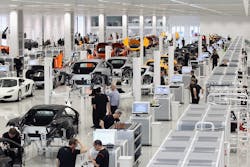At the recent American Society of Safety Engineers’ 2014 Professional Development Conference, Charles Duhigg, author of “The Power of Habit: Why We Do What We Do in Life and Business,” talked about the “emerging science of the neurology of habit formation” and its implications for the EHS profession.
“What we do everyday establishes the values that we live by,” Duhigg told attendees of the conference. “And that’s how cultural change really happens.”
Pointing to a Duke University study, Duhigg asserted that 40% to 45% of our daily actions are habits. Neurological research has shown that the brain “powers down” when in the midst of habitual behavior – with two exceptions.
According to a concept known as the “habit loop,” the brain experiences a surge in neurological activity when cued to begin the automatic behavior and when it receives a reward for the behavior. (Duhigg explained that habitual behavior has a three-part structure consisting of the cue, the routine itself and the reward.)
“If you can figure out the cues and rewards around your employees’ behavior, around your family members’ behavior, around your own behavior, you can change the habits that shape how they live everyday,” Duhigg asserted.
Procter & Gamble learned this concept the hard way. The company’s odor-eradicating Febreze spray flopped initially, in part because its potential customers were desensitized to the bad smells in their homes.
“The problem [P&G] realized was they were selling a product with a cue – bad smells – that people didn’t know that they even had in their life,” Duhigg explained. “And it promised a reward – getting rid of bad smells – that had no reward value for the people who needed it the most.”
So P&G went back to the drawing board, analyzing video footage of people cleaning their homes. The product development team decided to “piggyback on existing habits” and reposition Febreze as a way “to reward yourself for doing a good job cleaning,” Duhigg said. P&G added more perfume to the spray and produced news ads that portrayed Febreze as a happy ending to a freshly cleaned room.
Today, Febreze is one of a dozen or so P&G products that generate $1 billion a year in sales.
More on the using habit in your company see EHS.
EHS is an NED companion site within Penton’s Manufacturing & Supply Chain Group.
